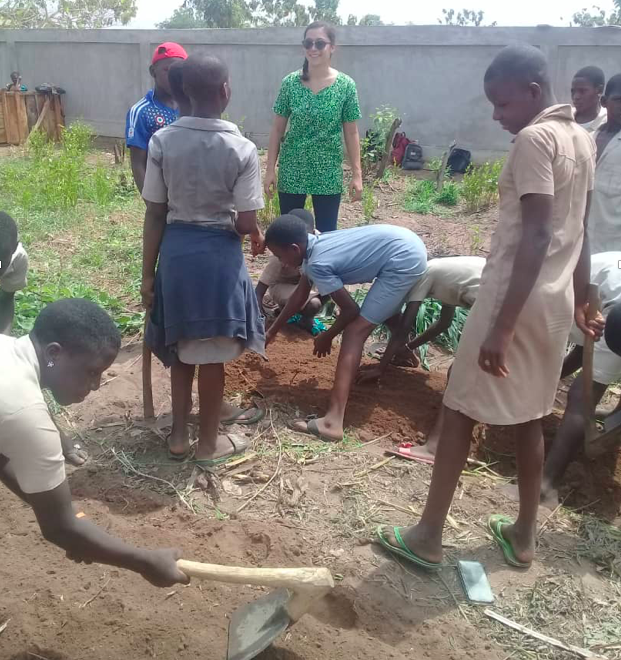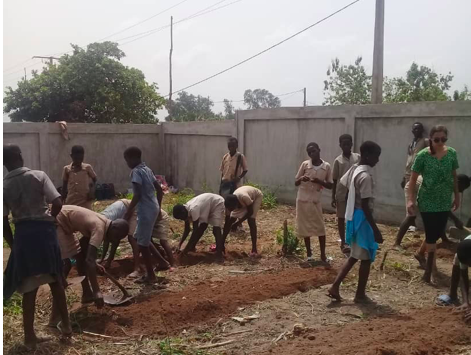Once a week, farmers from surrounding areas come to my village's market in rural Benin, West Africa, to sell everything from local produce to fabric to housewares. As grocery stores are a six-hour drive away in the capital, this local market is where everyone, including me, buys their local groceries.
Living in a rural town surrounded by rolling hills of farmland, you would picture this market to be abundant with local fruits and vegetables to eat, but unfortunately, that isn't the reality.
What can you find at the market? Tomatoes, okra, onions, and spicy peppers. Mangoes and bananas are available a quarter of the year, and oranges for half. As if this limited availability wasn’t hard enough, this produce travels from far distances and refrigeration is hard to come by, so vegetables often show up to market already rotten. Your weekly supply of vegetables is eaten on market day, or if you’re lucky, they may last for an extra day. This means that unless you grow vegetables yourself or know nearby farmers that sell produce during the week, your vegetable intake is limited to only a few days each week.
While I live in a small village in the middle of Benin, this is typical for most living in rural areas throughout the country, leaving 33.6% of households food insecure. Ultimately, 45% of children under 5 suffer from chronic malnutrition. Although these statistics are very daunting, most people, even in rural areas, have enough to eat. Being “fat” is desired and most people are willing to share any meal of the day with neighbors and friends. The real problem is not the quantity, but quality of available food. Seeing as there are limited fruits and vegetables available, most people rely on staple grains to make up most of their diet. As a food security volunteer, my goal is to change this.
At the local middle and high school, in partnership with the school director and life science teachers, we started a school garden to combat this pervasive food insecurity. Once a week, I met with students for a “Gardening Club” where we play games and have fun, but also learn everything from organic farming practices to nutrition. All students take part in planting and tending to our garden and at the end, will be able to take home vegetables to their families, along with the skills to grow them at home.
Together, we planted cabbage, cucumber, radishes, eggplant, carrots, and bell peppers. Almost all vegetables that you would need to travel hours to find. As a result, most students have never heard of or have seen these products, but after learning about how to cook them and incorporate them into their everyday meals, they were more than excited to make them a new regular in their diet.

Along with vegetables, we planted several moringa trees in our garden and across school grounds. Moringa, originally from India, is a tree that produces leaves with virtually all essential vitamins and minerals. The leaves can easily be added to sauces and local dishes to provide a nutritious boost to any meal. Planting moringa across school grounds makes these leaves available to all students and community members in my village, providing a communal source of improved food security.
Lacking knowledge of different vegetable varieties and organic farming techniques prevents many farmers from growing a wider variety of produce in and around small villages. Without being able to understand soil health and how to improve the soil using local, cheap methods, growing vegetables can be a challenge. By teaching these kids that you can make compost out of leaves found around village, or that water, spicy peppers, and soap are the perfect combination for organic natural pesticides, we are empowering young students to improve their own food insecurity.

Benin is an agriculture-based economy. According to the Food and Agriculture Organization, 80% of its population earns their income from agriculture. Despite this fact, agriculture is largely overlooked in the education system. Life science teachers at my local school have expressed what little emphasis is placed on agriculture and the local environment in their national curriculum. This leaves many students, most of whom will become farmers in the future, unprepared and without the technical knowledge to grow new products and improve their household food insecurity. By creating a school garden, it provides these teachers with a place to put these lessons into action and teach more about organic farming within the context of their own village.
This school garden has been beneficial in starting the conversation about food insecurity and chronic malnutrition in my community. While the garden is still in its beginning stages, we are hoping to empower community members to change this, one vegetable at a time.

Natalie Petrulla is a food security volunteer who has spent the past year and a half living in rural Benin, West Africa. While working in her community, she noticed a significant gap in nutrition education and access to nutritious foods. In partnership with her local middle and high school, she started a vegetable garden that is now being used as a platform to teach students about organic farming techniques and nutrition. At the end, students will have vegetables to bring home to prepare and new knowledge to start their own home garden and improve their household food security.